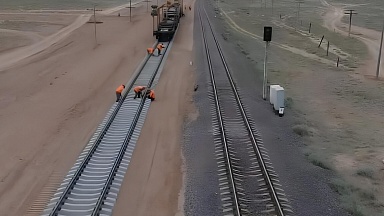In general, the primary and alternative routes of the New Silk Road are affected by geopolitics to a greater or lesser extent. To the north, the Ukraine-Russia crisis has monopolised the interest lately. The same goes for Lithuania and Belarus, which cut their rail freight ties.
To the south, Central Asia is in the midst of an eventful period: the unrest in Kazakhstan has been quelled by the intervention of external forces, but there is still fallout. Simultaneously, Armenia and Azerbaijan are in opposition, delaying the advancement of railway projects in the Caucasus.
Eastern Europe in political flames
Although Russia and Ukraine have said that their conflict will not escalate into war, Western media and politicians seem to be analysing the situation with a «pep talk» attitude. Some analysts predict that if the two countries come to blows, the US will impose economic sanctions on Russia, followed by the EU. Russia could counter by cutting off rail transport between China and Europe.
On the other hand, Lithuania used to be a mandatory stop between China and Kaliningrad. Still, due to the tense diplomatic relations between China and Lithuania, direct Chinese trains to the Baltic country ceased operations at the end of last year. Trains heading to Kaliningrad no longer stop in Vilnius, making the unloading of containers very complicated.
In addition, relations between Lithuania and Belarus are deteriorating. The Lithuanian Railways no longer transport Belarusian potash fertilisers, following the US sanctions imposed on Belarus in August 2021. In retaliation, the Belarusian government said it would ban trains from Lithuania from transiting its territory and was preparing further draconian measures. As a result of this ban, Lithuanian trains look to the possibility of diverting through Poland and Ukraine.
Fragile balance in Central Asia
Let’s start with Kazakhstan, a prime transit country for China-Europe trains. Violent protests that broke out in the country earlier in January led the government to declare a state of emergency in parts of the country.
Kazakhstan Railways KTZ later claimed that the transit trains had not been affected and that it would ensure the smooth operation of rail freight in the future. However, the situation in the country definitely caused serious concerns in the industry, which suddenly saw a pilar of the Eurasian supply chain ready to collapse. Thanks to the intervention of a third party (Russia), the unrest stopped for a short period, but turmoil is still observable in the country.
The Caucasus area is also subject to unrest. Armenia and Azerbaijan have not resolved their conflict, which from an open war in Nagorno-Karabakh in 2020, has now transformed into a geopolitical chess game. The two countries share disputed lands which are also parts of vital corridors. For instance, the International North-South Transport Corridor (INSTC) should pass through the Nagorno-Karabakh territory. Since this is a grey area, the corridor does not use the existing rail links and is practically inoperable.
What is the aftermath?
So far, the New Silk Road has proven its resilience, and trains did not experience much nuisance because of the developments mentioned above. However, the pattern observed in Eurasian corridors is becoming evident. As mentioned in the latest European Silk Road Summit, politics are gradually occupying more and more space in Eurasian transport.
Combining business and politics is not unusual, and the industry’s professionals are pretty aware of that fact. However, what happens with alternatives? The situation between Lithuania and China or Belarus might not be so significant since the Silk Road volumes through this route are relatively low.
That’s not the case with Russia, Ukraine and Kazakhstan, though. What if one of these countries becomes unreachable? What if the unrest in Kazakhstan escalated and rail links were cut off? What could happen if Russia invaded Ukraine or if the US imposed sanctions on Russia and the latest stopped the transit of China-Europe trains?
The industry still cannot answer these questions. The New Silk Road is resilient to external factors; it is shifting and transforming, but it also remains the same more or less. The dependency on specific routes and countries makes sense, but it could also pose problems after a point. Should more agility and flexibility become the main focus for future Silk Road developments? This is certainly some food for thought.



